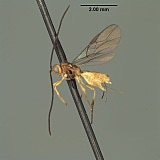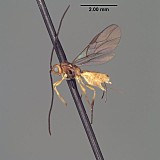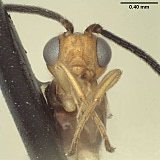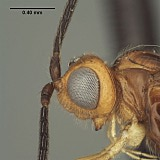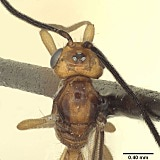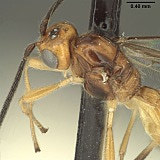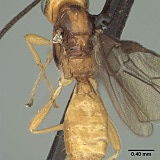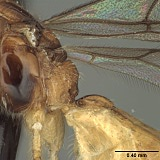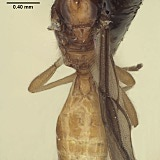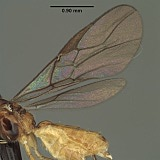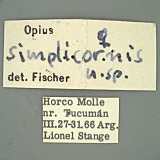Opius simplicornis Fischer
Opius simplicornis: Fischer 1971: 111 (catalog).
Opius (Pendopius) simplicornis: Fischer 1977: 714, 736–748 (key, redescription); Fischer 1979: 484–485 (key); Fischer 1983: 92; Yu et al. 2005, 2012 (electronic catalogs).
Fischer (1979: p. 493) compared O. simplicornis to O. caudisignatus Fischer and later (Fischer 1983: 92) to O. vinoanus Fischer. The former has a much longer ovipositor and the latter a more heavily sculptured T1 relative to O. simplicornis. The absence of a distinct anterior declivity on the mesoscutum suggests a relationship to members of the ingenticornis species group, but the antenna is shorter, with significantly fewer flagellomeres and T1 lacks the steep anterior declivity typical of nearly all members of this species group.
Additionally, this species shares the following characteristics with members of the ingenticornis species group: Mandible short, broadly triangular, dorsal margin strongly angled ventrally, broadly exposing labrum. Occipital carina broadly absent dorsally, the gap in dorsal view at least as wide as distance between eyes; carina well developed laterally and ventrally, widely separated from hypostomal carina ventrally. Mesoscutum without midpit; notaulus short, curved, pit-like anteriorly, narrowing and evanescent posteriorly. Propodeum with median depression at least anteriorly, never with median longitudinal carina. Mesopleuron without sternaulus; hind margin of mesopleuron not obviously crenulate on dorsal 0.5. Fore wing 2CUb arising from or near middle of first subdiscal cell. Hind wing with RS distinctly infumate; m-cu absent. T1 with dorsal carinae parallel or nearly so, extending from base to apex; laterope large, deep; dorsope absent.
There are no specimens currently determined for this OTU, or those specimens determined for this OTU are not yet mappable.
This material is based upon work supported by the National Science Foundation under Grant Number DEB 0949027 and associated REU supplement 1213790.
Any opinions, findings, and conclusions or recommendations expressed in this material are those of the author(s) and do not necessarily reflect the views of the National Science Foundation.
